The Unsolvable Shugborough Inscription, the Priory of Sion, and the Holy Grail
Almost two decades ago, Dan Brown’s blockbuster novel The Da Vinci Code won over millions of readers with an entertaining pseudo-historical adventure to find the Holy Grail. And with a new interest in historical conspiracy theories and secret societies, a spotlight was put on the Shugborough Inscription at Shugborough Hall, a sequence of ten letters that form one of the most mysterious and famous uncracked codes in history. Many theories have been proposed over the years, with the most popular and thrilling theory linking the Shugborough Inscription to both the Holy Grail and the fictitious secret society the Priory of Sion (and we don’t just have The Da Vinci Code to thank for this!).
Shugborough Hall and the Shepherd’s Monument
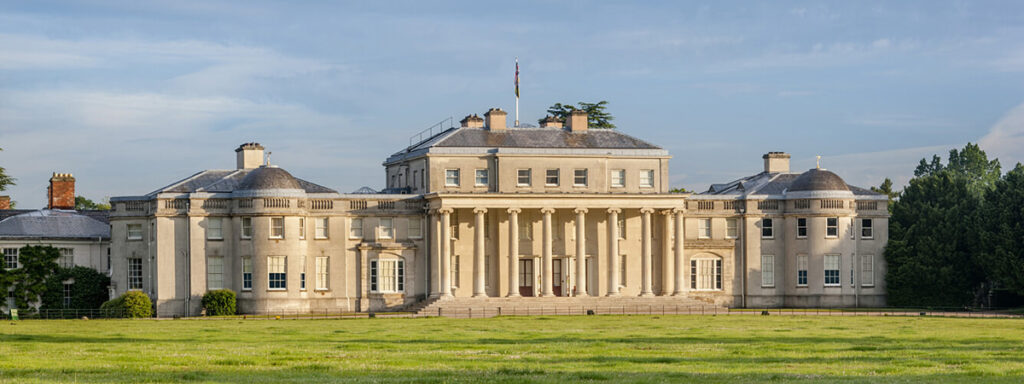
Shugborough Hall is a National Trust property located just short of 6 miles east of Stafford in Staffordshire, England. Originally, the estate was owned by the Bishops of Lichfield prior to the Dissolution of the Monasteries in about 1540. The original manor house was demolished in 1693 and a three-story home was built in it’s place with additions completed during the following centuries.
The house was open to the public in 1966 via the National Trust and managed by Staffordshire County Council. During this time, Patrick Lichfield, 5th Earl of Lichfield continued to live in an apartment in the Hall until his death in 2005. In 2016 Staffordshire Council gave Shugborough Hall back to the National Trust for management and the property continues to be open to the public to this day.

Located on the grounds of Shugborough Hall is the Shepherd’s Monument, which was constructed sometime during the eighteenth century. The relief carving is a mirrored reproduction of Et in Arcadia ego (or The Shepherds of Arcadia) painted by French artist Nicolas Poussin between 1637-1638. The scene shows four shepherds examining an inscription on a tomb that says Et in Arcadio ego (a Latin phrase meaning ‘Even in Arcadia, there am I‘). The scene is set in Arcadia, a province in Greece dating back to antiquity and used in the arts to represent an idyllic and pastoral life that’s so perfect it’s impossible to obtain.
The original painting is generally considered a memento mori (Latin term meaning ‘remember you must die’). Memento mori‘s are artworks designed with the purpose of reminding the viewer of their own mortality. The name of the painting as well as the inscription implies that even in a utopia such as Arcadia, death still exists (the ‘I’ in ‘there am I‘ is thought to refer to Death).
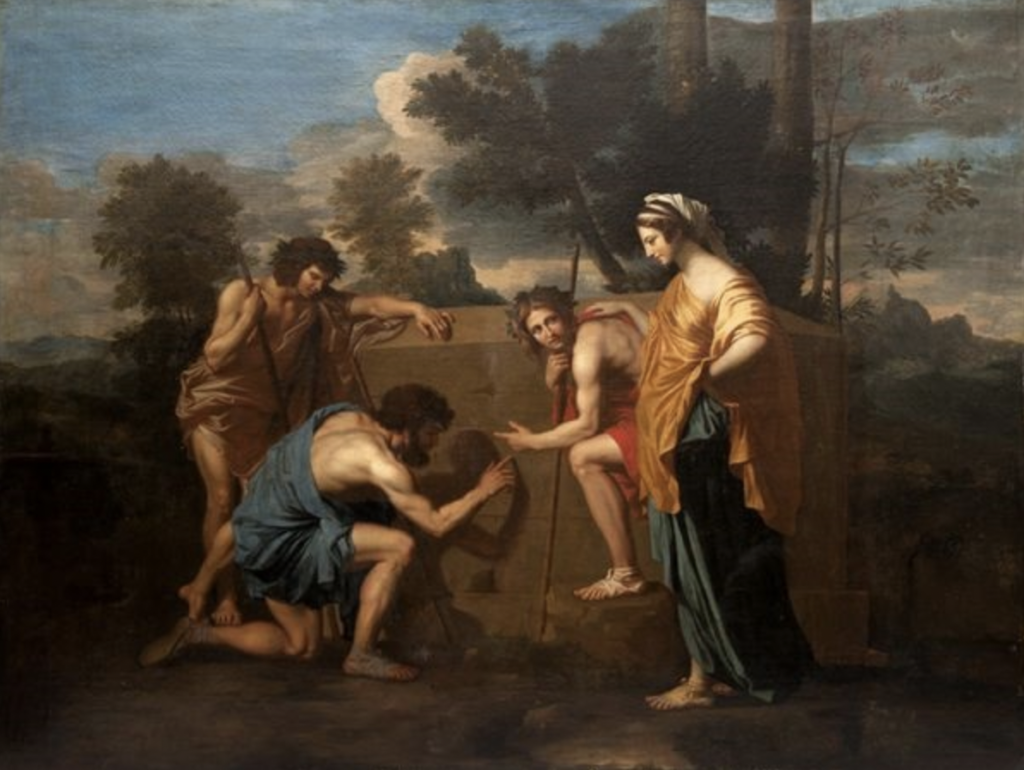

While the relief sculpture is certainly beautiful, it isn’t the main appeal of The Shepherd’s Monument. Carved below the reproduction of Poussin’s Et in Arcadia ego are two lines of letters: O U O S V A V V and D M. Now known as the Shugborough Inscription, the mystery of these seemingly random letters is that absolutely no one has any idea what they mean. Hundreds of theories, some plausible and some based in conspiracy have been proposed throughout the years, however none have been convincing enough to consider the Shugborough code cracked. And one of the most popular theories is that the Shugborough Inscription is a secret message disclosing the location of the Holy Grail.
In Christian tradition, the Holy Grail was the vessel used by Jesus to serve wine to his apostles at the Last Supper and then by Joseph of Arimathea (who was responsible for the burial of Jesus) to collect the blood of Christ during his crucifixion. The Holy Grail was also popularised through Arthurian tradition. For the Knight’s of King Arthur, the quest for the Holy Grail was a central focus of the narrative and what most people associate with the mythological king and his Knights of the Round Table.
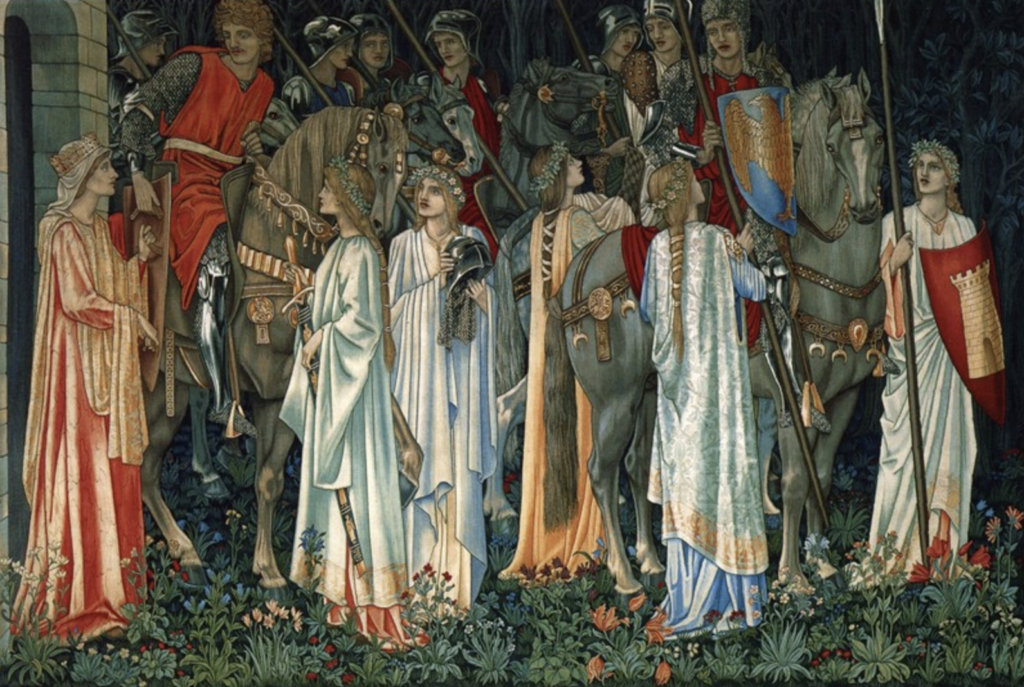
But if the Holy Grail exists, where is it today? One popular theory is that the Grail was taken by Joseph of Arimathea to Glastonbury, England where it was buried (see the Curious Archive post King Arthur’s Tomb at Glastonbury Abbey, Somerset). Another theory says the Knight’s Templar stole the Holy Grail from Temple Mount in the Old City of Jerusalem during the Crusades and hid it away in a secret location. And there are others who suspect a Da Vinci Code-esque cypher is engraved on The Shepherd’s Monument at Shugborough Hall and, when solved, will provide a clue to the location of the Holy Grail.
The theory originally came from the bestselling pseudo-historical book The Holy Blood and the Holy Grail (1982) by Michael Baigent, Richard Leigh, and Henry Lincoln. The book put forward the theory that Jesus married Mary Magdalene and had children, implying that there was a living Holy bloodline. The descendants of Jesus and Mary were then said to move to Southern France and marry into noble families that became the Merovingian dynasty. The Merovingian dynasty, who had a special claim to the French throne, was protected by a secret society known as the Priory of Sion. The Holy Grail, according to the book, is not a physical object but the womb of Mary Magdalene and the descendants of Jesus himself.
However, this is a theory; one that has been debunked by journalists and historians. But there are plenty of people that are convinced that the contents of The Holy Blood and the Holy Grail are not only plausible, but entirely factual. And it hasn’t helped that The Da Vinci Code was inspired by The Holy Blood and the Holy Grail, further romanticising the idea of a Holy royal bloodline protected by a secret society.
Another theory put forward by the book was the bold but fascinating claim that the Shugborough Inscription itself had a direct tie to the Priory of Sion.
The Priory of Sion was founded in France in 1956 by Pierre Plantard de Saint-Clair and dissolved the same year. Plantard claimed the Priory of Sion was a ‘front’ for a secret society founded on Mount Zion, Jerusalem in 1099 by Godfrey of Bouillon, one of the leaders of the First Crusade and first ruler of the Kingdom of Jerusalem. The secret society was said to see a number of lustrous members, most famously former Grand Masters Leonardo da Vinci and Isaac Newton. According to Plantard, the Priory of Sion had been conspiring to install the secret bloodline of the Merovingian dynasty on the throne in both France and Europe for the past millennium. But it was The Holy Blood and Holy Grail, not Plantard, that then took Plantard’s claims and merged them with the theory of a bloodline belonging to the family of Jesus.

Like The Holy Blood and the Holy Grail, Plantard’s Priory of Sion has little historical backing and is widely considered to be a hoax and conspiracy theory. Plantard and his friend Philippe de Chérisey created false evidence during the 1960s in an attempt to make the Priory of Sion appear more legitimate in its claims. This included two forged medieval documents with encrypted messages referencing the Priory of Sion as well as a 27-page document called Dossiers Secrets d’Henri Lobineau (in English, “Secret Files of Henri Lobineau”). This document included genealogy charts claiming to prove Plantard as a descendent of Merovingian king Dagobert II, inserting himself directly into the lineage of the medieval dynasty and making the Priory of Sion a very ego driven pursuit.
The Latin phrase Et in Arcadia ego (the painting The Shepherd’s Monument was based on), was ‘borrowed’ by Plantard for the motto of both the Priory of Sion as well as his family. Furthermore, The Holy Blood and the Holy Grail suggested that Poussin, the artist of Et in Arcadia ego, was a member of the the Priory of Sion and that his painting contained hidden esoteric secrets. Based on this, there are many who believe that the Shugborough Inscription O U O S V A V V and D M has some sort of connection with the Priory of Sion and the location of the Holy Grail, whether its a physical object or the proposed Holy bloodline. And rumours of the Anson family (who owned Shugborough Hall when The Shepherd’s Monument was built) as Grand Masters of the Knights Templar and members of the Priory of Sion have certainly helped fan the conspiracy flame.
Bletchley Park vs. the Shugborough Inscription
The renewed interest following the publication of The Da Vinci Code and the reintroduction of The Holy Blood and the Holy Grail into the mainstream was harnessed by Shugborough Estate general manger Richard Kemp who launched a promotional campaign in 2004 where Bletchley Park veterans were invited to tackle the unsolvable code. Created during WWII, Bletchley Park in Buckinghamshire was a government cryptological establishment that decoded secret messages encrypted with the German Enigma and Tunny cipher machines. According to Britannica, experts believe the staff at Bletchley Park, consisting of nearly 9,000 code breakers (three-fourths of which were women) may have contributed to shortening the war by up to two years. Needless to say, the Bletchley Park codebreakers were among the best in the world. So all eyes were on Bletchley veterans Oliver and Sheila Lawn and a team from the Government Communication Centre when they came to Shugborough Estate in May 2004 to examine the The Shepherd’s Monument.
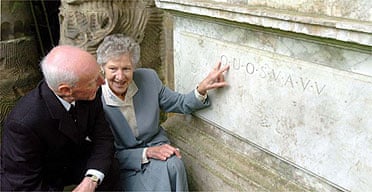
After examining the Inscription, Oliver believed that both the sculpture (Et in Arcadia ego) as well as the two lines of letters needed to be considered together in order to crack the code. He told The Guardian:
It is totally different in terms of difficulty to what I used to do during the war. I think you need classical knowledge as well as ingenuity. This is a language rather than a mathematical code. Within its genre I would say it’s the most challenging I have ever had to tackle. What we need is a bit more intelligence about the family from the documents held at the estate to try and find a key to breaking this. There is always a key, but if this was a code between two people and only they knew it, it could be almost impossible to decipher.
In November 2004 The Guardian ran a follow-up article to announce their findings. Surprisingly, the team proposed the Shugborough Inscription stood for “Jesus (As Deity) Defy”, a message they claimed was left by the Priory of Sion. The theory came from ‘an anonymous US researcher’ with a background in defence and advanced code-breaking. (It’s unclear from the article if this researcher was part of the Lawn team, or if he worked independently and answered their appeal for theories at the beginning of the year.) The idea of Jesus as an earthly and not heavenly king, as suggested by “Jesus (As Deity) Defy”, goes against traditional Christian beliefs. However, this concept is in-line with ideologies of the Knights Templar who some believe have links to the Priory of Sion. The team then used this train of thought to connect the Shugborough Code with the fictitious secret society.
However, I personally question the historical legitimacy of these claims, especially since historians have spent decades denouncing The Holy Blood and the Holy Grail and the existence of the Priory of Sion. It seems convenient that Kemp launched a campaign to piggyback off The Da Vinci Code hype and have codebreakers coincidentally discover that the Shugborough Inscription has links to the Priory of Sion and the Holy Grail. Call me sceptical, but I question if Kemp’s campaign was more of a marketing gimmick than an attempt at decoding the Shugborough Inscription. Not that I blame him for trying; The National Trust is crucial for the cultural preservation of historic buildings in the country, but it’s a shame that claiming pseudohistorical theories as fact was used to attract more visitors.
Beyond the Holy Grail: Other Theories of the Shugborough Inscription
While undeniably interesting, the theory that the Shugborough Inscription is linked to a Grail quest is shaky at best, but it’s easy to see why it’s the most popular. Here are four other (but still fascinating!) theories that have been proposed throughout the years:

Sebastiano del Piombo (1517-1519) The National Gallery, London.
The Shepard’s Monument as a Rosicrucian Manifesto
This theory was put forward by Øystein Rustad on his website The Shugborough Inscription Deciphered. Rustad believes that the two inscriptions on the Shepard’s Monument, both the mysterious letters and the phrase Et in Arcadia ego, are “a Rosicrucian manifesto pointing to the origin of the Rose Cross“. Unlike the Priory of Sion, Rustad says that this theory is more plausible since Rosicrucianism is a real secret society. However, Rosicrucianism isn’t without it’s own legitimacy issues. Christian Rosenkreuz, the claimed founder of the Rosicrucian Order was said to be Lazarus or St. John in a previous life, but whether or not Rosenkreuz even existed is up for debate.
The Shugborough Inscription as a Treasure Map
In 2016 George Edmunds’ book Anson’s Gold: And the Secret to Captain Kidd’s Charts proposed that the Shugborough Inscription was concealing the latitude and longitude of a multi-million pound treasure buried on an unknown island. Edmunds’ suggests that George Anson, a Royal Navy officer who was born at Shugborough Manor in 1697, launched a secret expedition to find the hidden Spanish treasure. Once discovered, the location of the island was sent back to Anson in a code that reportadly included part of the Shugborough Inscription. According to the book, the location of the treasure is hidden in the inscription and following the coordinates will lead to the buried treasure. Why the treasure was left on the island and not brought back to Shugborough Estate is unknown.
The Shugborough Inscription as a Biblical Verse
Keith Massey, former NSA linguist, Latin Professor, Biblical scholar, and Eastern Orthodox priest put forth the theory that the letters on The Shepherd’s Monument are initials for the Latin phrase Oro Ut Omnes Sequantur Viam Ad Veram Ad Veram Vitam (“I pray that all may follow the Way to true Life”). The phrase references the Biblical verse John 14:6, Ego sum Via et Veritas et Vita (“I am the Way, the Truth and the Life”).
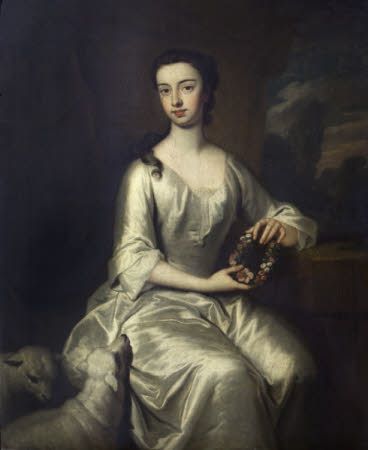
The Shugborough Inscription as a Dedication to the Deceased
English novelist Oliver Stonor also proposed the letters were initials. However, instead of a biblical verse, Stonor suggested that the initials formed a dedication by George Anson to his deceased wife Lady Elizabeth Yorke (1725-1760). In this case, the letters spell out the Latin phrase Optimae Uxoris Optimae Sororis Viduus Amantissimus Vovit Virtutibus (“Best of wives, Best of sisters, a most devoted Widower dedicates (this) to your virtues”).
The more you dig into the online world of Shugborough Inscription theories, the deeper the rabbit hole gets. Nostradamus, who wrote Les Prophéties in 1555 (a text said to prophesise future events) is thought to be tied to the Shugborough Inscription. And since there are a fair amount of UFO sightings around Staffordshire, aliens have made their way into the narrative. There are also mentions of the Shugborough Estate sitting on a ley line and that The Shepherd’s Monument was erected on the site specifically because of the area’s ‘energy’.
It’s obvious that the conversations surrounding the Shugborough Inscription tick most conspiracy theory boxes. But truthfully, that’s what makes the entire mystery so much fun. I doubt the actual answer to the code is as interesting as the stories people have come up with over the years. So does the deciphered inscription lead to the Holy Grail? Are the letters initials of a Latin phrase? A Poem? A Biblical verse? Or, like the Voynich manuscript is the Shugborough Inscription a three-hundred year old hoax? The answer, unfortunately, may be lost to time.
Sources and Additional Reading:
BBC – Holy Grail ‘lies at stately home’
Britannica – Bletchley Park
History – What is the Holy Grail?
Staffordshire County Council – The Mysterious Ancient Cryptic Code of The Shepherd’s Monument
Tate – Art Term: Memento Mori
The Guardian – Bletchley veterans tackle ‘toughest puzzle yet’
The British Library – The Quest for the Holy Grail
Wikipedia – Et in Arcadia ego
Wikipedia – Merovingian dynasty
